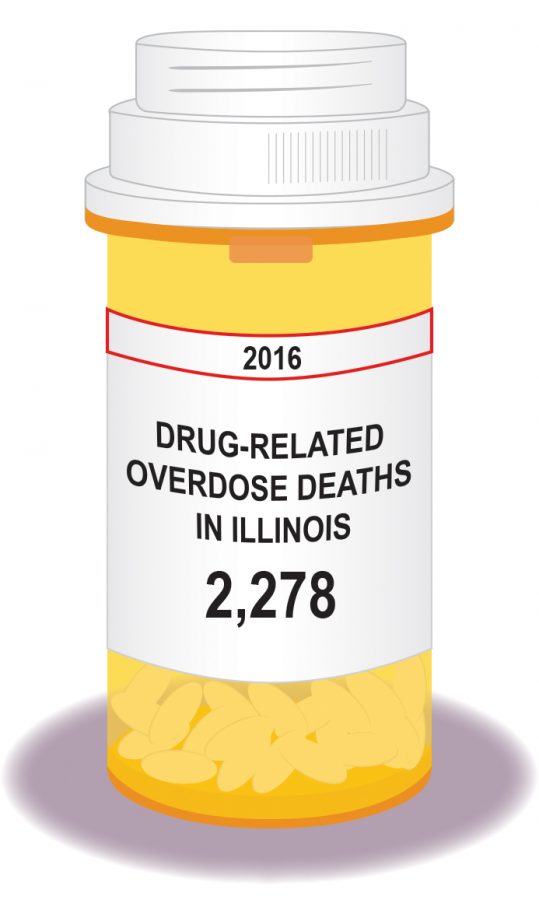Illinois receives federal assistance to combat ‘opioid crisis’
Illinois receives federal assistance to combat ‘opioid crisis’
May 8, 2017
A multimillion dollar federal grant awarded to the Illinois Department of Human Services will help create and fund projects dedicated to fighting the state’s opioid crisis, according to an April 25 IDHS press release.
More than $16 million from the U.S. Department of Health and Human Services will be directed to the Opioid Crisis Grant. Some of the proposed projects include a crisis line, emergency hospital screenings and expanded distribution of naloxone—an emergency opioid overdose medication.
Eighty percent of the money will go to treatment and recovery services. The remaining 20 percent will support prevention services. The projects are expected to begin serving individuals within the next three months, said IDHS Director of Communications Meredith Krantz in a May 4 email to The Chronicle.
“As has been the case nationally, Illinois has been severely impacted by the opioid epidemic,” IDHS Secretary James Dimas said in the press release. “This significant investment will strengthen statewide services and expand access to treatment and overdose prevention programs in Illinois.”
In 2015, Cook County had 609 opioid-related overdose deaths, 403 of which were in Chicago. Heroin cases accounted for 424 of those countywide deaths, including 285 in Chicago, as reported Oct. 17, 2016, by The Chronicle.
Dan Bigg, director of the Chicago Recovery Alliance, said naloxone is a “pure antidote” that can save an opioid addict’s life. CRA, which teaches about and distributes the medication, has reached 90,000 people and reports more than 11,000 reversals using this drug. He added that two other key drugs—methadone and buprenorphine—need to be available for other treatments of opioid dependence.
“Illinois is missing a huge opportunity,” Bigg said. “The only way to expand [the] system is to make methadone treatments [available] for the first time in physician offices, then loosening the bureaucracy around the use of buprenorphine.”
Bigg said the majority of physicians cannot prescribe buprenorphine because they have not been willing to undergo the scrutiny by the Drug Enforcement Agency, which keeps track of physicians who have trained to get a license to treat addiction.
“We have more than half a century’s worth of data that shows giving somebody methadone or buprenorphine as a substitute for the heroin they’re using is one of the most effective, [impactful] community overdose prevention initiatives that can exist,” Bigg said.
Federal funding of programs that prevent opioid addictions “absolutely” saves lives, said Chris Hoff, assistant director of Community Health Resources for the DuPage County Health Department. The county was awarded a grant last year, which helped to fund anti-overdose programs including its DuPage Narcan Program—which supplies and teaches police officers how to administer the drug—and has saved 275 lives in the form of drug reversals since 2014, according to Hoff.
He added that he thinks the opioid problem will be solved through the work of these programs and from creating environments in which people do not feel the need or are pressured into trying and possibly becoming addicted to opioids.
“There will not be a way to prevent every person everywhere from trying or becoming addicted to drugs, so we need a system that supports ongoing treatment and multiple attempts at treatment,” Hoff said.
While the Opioid Crisis Grant program is a good start, Leonard Jason, professor of psychology at DePaul University and director at the school’s Center for Community Research, said there needs to be more funding and a variety of programs given the “nature of the crisis.” He suggested another outlet to explore is recovery homes that provide individual, safe assistance for those who are treating and recovering from opioid addiction.
“People need to be surrounded by people who are not using [drugs and] who are employed, good citizens,” Jason said. “Individuals, particularly coming out of jail, prison and other total institutions, probably need places to live that are safe.”
Jason said the nation’s opioid abuse problem needs creative solutions, resources and opportunities available for all who are affected. Currently, the country spends an annual $450 billion on alcohol and substance abuse and costs associated with abuse, which is more expensive than the national cost of services for people with cardiac issues, he added.
“It affects the economy when people can’t go to work, personal relationships when people can’t relate to others and children when parents are using substances,” Jason said. “[It has effects] throughout the entire nation.”








